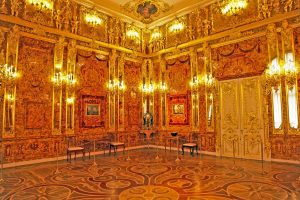
The Amber Room, St Petersburg has been on my list of places to visit for many years and after the lockdown I am going to make my travel plans. I had no idea what an interesting history lay behind The Amber Room.
The very first Amber Room was constructed in 1701 and installed by the first King of Prussia, Friedrich I. This remarkable concept was designed by German baroque sculptor, Andreas Schluter and the Danish amber craftsman, Gottfried Wolfam.
When Peter the Great visited the King of Prussia, he admired the room so much that Friedrich gifted the entire collection cementing a Prussian-Russian collaboration against Sweden. The Amber Room was packed into 18 large boxes and shipped to Russia and installed into The Winer House, St Petersburg.
In 1755, Czarina Elizabeth moved the room to Catherine Palace, the Italian designer, Bartolomeo Franscesco Rastrelli using additional amber from Berlin to redesign The Amber Room into a larger space.
After further renovations, the final Amber Room had 6 tons of amber and was used as a meditation chamber for Cazarina Elizabeth and a trophy space for the amber connoisseur, Alexander II.
June 22, 1941, Germany invaded Russia and led to the looting of multiple art treasures, including The Amber Room. The Amber Room was packed in 27 crates and shipped to Konigberg (today Kaliningrad), and reinstalled at the Castle museum. The museum’s director, Alfred Rohde, was an amber aficionado and displayed the amber for 2 years, that was until the Castle museum was destroyed by allied bombing. The trail of The Amber Room stops here and there are multiple conspiracy theories about where the amber is today.
In 1979, the start of the new Amber Room began and 25 years later (and a price of $11million) it was opened in 2003 by Vladimir Putin and the then German Chancellor, Gerhard Schroder, celebrating the 300-year anniversary of St Petersburg.
